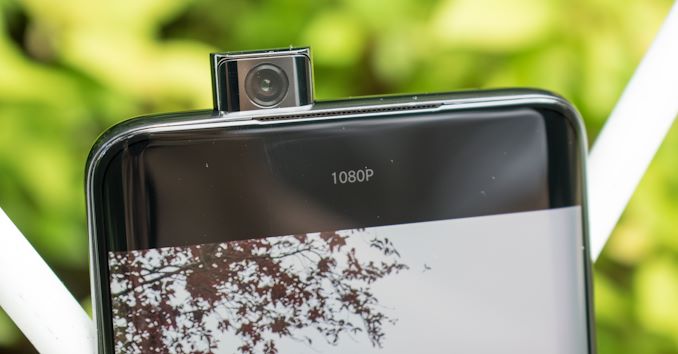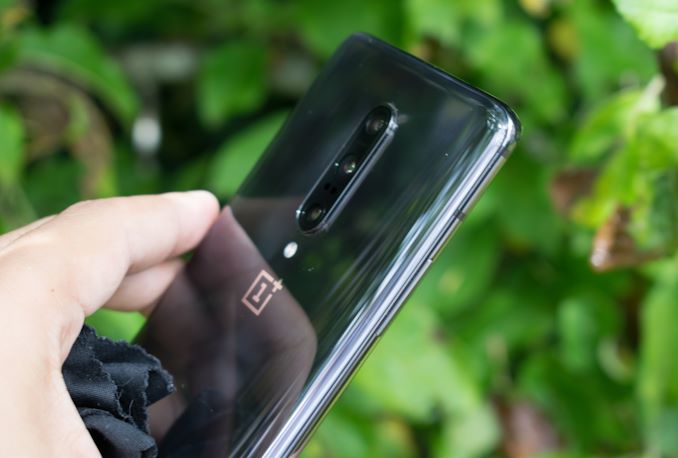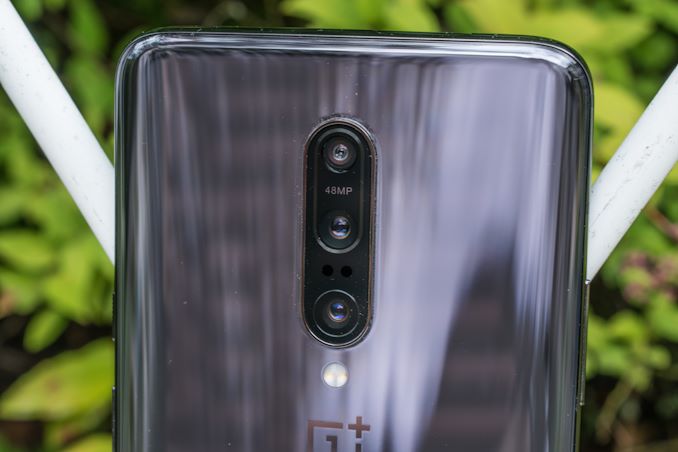The OnePlus 7 Pro Review: Outstanding Performance & Screen, Adequate Everything Else
by Andrei Frumusanu on June 19, 2019 12:00 PM EST- Posted in
- Mobile
- Smartphones
- OnePlus
- OnePlus 7 Pro
Conclusion & End Remarks
As we’re wrapping up this review, the main question for me and a lot of users for is whether the OnePlus 7 Pro is worth the additional cost, and if it makes a successful landing in its new higher price category whilst maintaining the company’s mantra of offering the best value for the money.
In terms of design, I really liked the OnePlus 7 Pro and I had very little to complain about the new form. This is OnePlus’ first curved screen phone, and whilst I think some vendors by experience have gone back to slightly tighter radius curvatures on their displays, for the OP7Pro it’s still something that you can definitely get used to, and it does improve ergonomics a lot.
In terms of ergonomics, my subjective feeling is that this is a bit too big a phone for me, but for users who are looking into iPhone Plus / Max and Galaxy Note-sized devices, it’ll be a perfect fit. It’s also a very heavy device in the same weight category as the aforementioned devices, so this is something you'll want to consider.
The new display of the OnePlus 7 Pro is easily its single best feature. This is not only because it’s OnePlus’ first ever 1440p screen which is a great improvement in sharpness, but it’s the very first OLED 1440p 90Hz screen on the market.
Overall in terms of the fundamentals of the display, the unit does not disappoint. OnePlus did a very good job in terms of colour calibration with the Natural mode and it’s up there among the best devices, and thus far the best Android device screen in 2019. Brightness was an area of improvement, as OnePlus makes you choose between a brighter Vivid mode with inaccurate colours, or an accurate Natural mode which doesn’t quite go as bright as advertised in daylight.
The 90Hz mode is the single biggest killer feature of the phone and there will be people who will be choosing the OnePlus 7 Pro over other contenders solely for this. This was my opinion when I first held the phone, and I maintain this view after spending sufficient time with it. I think that this is the way forward for phone manufacturers to differentiate themselves. It’s just that much of an outstanding experience.
An outstanding experience is also the performance of the phone. The combination of the 90Hz mode with the new Snapdragon 855 SoC as well as the new UFS 3.0 storage employed in the 7Pro means this is currently the snappiest, and best user experience phone out there.
The performance benefits extend to gaming as well: OnePlus was able to achieve a good thermal dissipation design that seemingly is able to sustain peak performance indefinitely, squeeing out the full potential of the Snapdragon 855, although the phone can get a bit toasty and it does eat up a lot of battery like this.
Speaking of battery, the OnePlus 7 Pro is average to good, and essentially ended up where I had expected it to. I don’t have definitive evidence of this, but the new 90Hz screen is largely suspected as the cause for a larger base power consumption. So even though OnePlus has implemented the new feature in the best way possible, there’s still an unavoidable power hit, and the phone doesn’t last as long as say the P30 Pro or Galaxy S10+ even though they're all in the same range in terms of battery capacity.
The 60Hz mode is a novelty and there’s really no reason to use it, you’re better off with a different phone if you’re avoiding the key feature of the OnePlus 7 Pro.
The cameras of the OnePlus 7 Pro is where things become a bit painful and unfortunate.
First of all, let’s get the front-facing pop-up camera out of the way. It’s a good module, but personally I do think the added weight, internal complexity as well as longevity risk (if you get debris inside) are too big compromises. Yes the full bezel-less screen screen is fantastic, but I could have also just lived with a minimal forehead or just a blacked out status bar with a small notch.
In daylight capture, the OnePlus 7 Pro is a good phone and it has a good camera, but it’s not quite competitive against 2019’s flagship devices. In particular we saw that OnePlus’ processing isn’t able to fully extract what’s actually possible with the new camera sensor. The fact that it’s 48MP is generally irrelevant for 99% of users, OnePlus could have simply gone with a traditional 12MP sensor and likely gotten better results.
The processing reminded me a bit too much of the Pixel 3 in daylight, meaning it lacked sufficient dynamic range and it had the bad habit of over-emphasising shadows that weren’t actually there. There’s some shots where the 7Pro is just worse than the 6T.
The wide-angle, while an excellent addition to the overall shooting experience, suffered from the same processing effects as the main camera. On top of this, it’s visible that the module’s lens is of much lower quality than what’s seen by other manufacturers, causing more distortion and bad chromatic aberrations around the frame edges.
The telephoto module was in my opinion good, and got surprisingly very sharp results. The 3x zoom is a good compromise between 2x and some of the newer more crazy high magnification phones.
Low-light capture of the OnePlus 7 Pro would have been something competitive in 2018, however this year OnePlus had to step it up in terms of its computational photography. Cameras are among the very last things a manufacturer works on when designing a new phone, so it’s possible that over the next few months the company will be able to further improve things. However as it stands, the OnePlus 7 Pro falls behind not only the low-light kings from Huawei, but also now falls behind Samsung as the Galaxy phones are getting updated with a significantly better Night mode.
Video recording has also been soundly disappointing for the fact that it feels the OP7Pro’s camera is just unfinished in this regard, and lacks any option to use the wide-angle or telephoto lenses. On the main module, EIS quality is a bit disappointing and there’s a lack of dynamic range, either through captured sensor HDR or actually natively recorded HDR modes.
Speakers on the OnePlus 7 Pro have massively improved compared to its predecessor, so credit where it's due even though they don't quite match Apple or Samsung's offerings.
In the end I see there’s going to be only one type of person who should consider the OnePlus 7 Pro over say a Galaxy S10+: If you value performance and device fluidity more than anything else, the 90Hz display, the SoC, and the storage speed of the OnePlus just beats out any other contender in this regard.
However for me I feel that the phone is cutting a bit too many corner in terms of its camera. I could have lived with the slightly worse speakers and somewhat lower battery performance in order to enjoy the fantastic 90Hz screen, however the camera disadvantages are just a tad too much. OnePlus can very much remedy these aspects over the coming weeks and months, and I’m very sure there will be software updates in this regard, but it's unknown just exactly how much OnePlus will improve these aspects, and one shouldn’t base one’s purchasing decisions today on tomorrow’s possible improvements.













91 Comments
View All Comments
zodiacfml - Thursday, June 20, 2019 - link
Additionally, it is essentially heat that hurts batteries regardless of charging rates. One PLus' implementation of rapid charging might be less harmful or the same as other fast charging techniquescha0z_ - Monday, July 1, 2019 - link
Correct and at the same time wrong. Yes, heat degrades batteries faster, but it's not the only factor. How fast you put charge in the battery also leads to degradation. Enough materials on the web to explain in details - google it.ZoZo - Wednesday, June 19, 2019 - link
I bought that phone, tested it for about 30 minutes, then sent it back.The curved display is just not for me, especially because they made it so much more curved than on Samsung phones.
1. Things tend to "fall off" the edges and give the impression that the screen is too narrow, it's annoying.
2. Colors are shifted on the edges, especially if you don't hold the phone exactly parallel to your eyes. White appears grayish green.
3. Glare is more frequent as light can be reflected not only from the front of the display, but also from its sides.
What a waste.
ZoZo - Wednesday, June 19, 2019 - link
I'll just add that I don't understand how most reviewers overlooked these problems. Is it just me?RSAUser - Wednesday, June 19, 2019 - link
Nope, I hate pretty much all curves besides 2.5D since it makes it easier to grip, but it doesn't mean the image display itself has to be curved.GC2:CS - Wednesday, June 19, 2019 - link
It is good to know that this phone does come with compromises built in, unlike some other sites that make you believe that this phone (like the phone released a week ago) is going to change the whole industry, just because it is cheap.Some points
1. Do you have some power measurements at peak sustained power or it has been done before ?
-> Am I the only one who thinks that increasing performance on mobile, by implementing heat pipes, coper plates and fans, and run it all as hot as possible is just ridiculous ?!?
2. This device supposedly comes without display lamination ! Can someone confirm/deny ? OLED's will get destroyed when exposed to humidity.
3. Regarding high refresh rates, we really need an Apple implementation- custom T-CON, GPU regulating the refresh and continuously variable refresh rate in a wide range (like 24-120 fps) to save energy. To my knowledge this is possible thanks to IGZO backplane iPad pro uses. And no OLED panel is using that yet. Is there a compatibility problem ?
martixy - Wednesday, June 19, 2019 - link
I could not care less about the camera and the rest looks like an amazing package(bar lack of 3.5mm), but this is a skip for me because WiFi 6 is on the horizon and I'm going all in when it arrives.Flunk - Wednesday, June 19, 2019 - link
If I was looking for a new phone right now, this would be the obvious one (I love my OnePlus 5T), but it looks like the price has creeped up to near top-end pricing. Not only that, but OnePlus seems to realize that too with the OnePlus 7 and 7 Pro. Unfortunately the 7 is not available in my market, which is very frustrating. I'd have to pay for a battery-sapping screen and 2 additional novelty cameras that I'd never use.All in, if I broke my current phone tomorrow I'd have to go on a hunt for my new phone instead of just going back to OnePlus because this phone is just too expensive and it's only too expensive because of those gimmicks.
syxbit - Wednesday, June 19, 2019 - link
>>This is not only because it’s OnePlus’ first ever 1440p screen which is a great improvement in sharpness,Can you tell the difference between 1080p and 1440p on a 6" device?
Andrei Frumusanu - Wednesday, June 19, 2019 - link
Yes, very much.